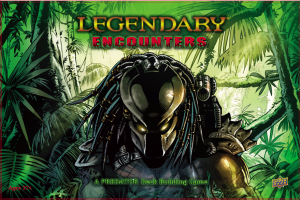Posts in Category: Games
GenCon 50
This year was the 50th anniversary of GenCon and it was a large and amazing trip. We went out for all four days and managed to try some new things. I played my first convention RPG session, the Starfinder test game. It was not bad but it did feel a bit off. We played a much more mechanical combat mission. With the mat and miniatures it felt more like a board-game than a true RPG experience. It was hard for me to build rapport with stranger so that I could play my character’s personality beyond the archetype.
Another new experience this trip was eating from the food trucks and drinking in the beer tent. In years past we’ve had minors in tow and it was difficult to try these things. The Sun King beer was very good and the wait for dinner was not terrible. The people in line were friendly and the food was very tasty.
The expanded exhibit hall was still very cramped. It could have been the record attendance but the experience matched years past with being bumped and jostled and slowly wading through people to get anywhere. The stadium display of GenCon’s history was very well done and I hope GenCon continues to move more things into the stadium in future years.
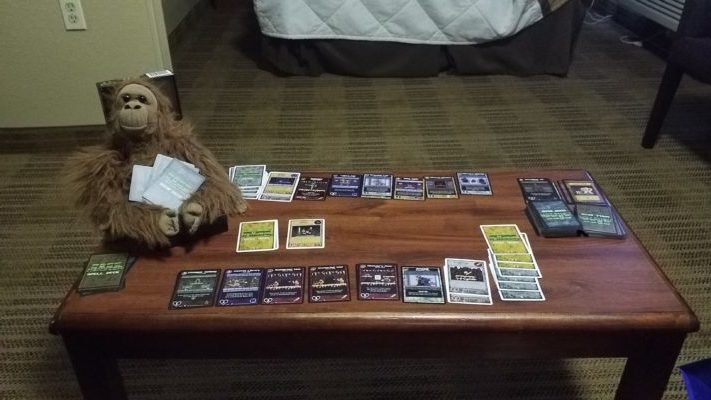

Boss Monster – a review
Boss Monster is a card game where the players take the roll of a villian from an 8 bit side scroller video game. You build a dungeon with monsters and traps. You lure adventurers into your lair and hopefully they expire before reading your chamber. The first to collect 20 souls wins If you get hit with 5 wounds from adventures who proved too hearty to sucumb to your designs you lose.
This is an easy game to learn/play. You setup by taking a monster, five room cards and two spell cards. You then display adeventurers (one per player) and then you pick a room to build, laying the card face down. You reveal your room simultaneously with the other players and put it in your dungeon. At the bottom of each room card there are helpful icons that tell you what type of adventurer you attract: swords for fighters, books for mages, holy symbols for clerics and money bags for thieves. You count the number of icons on the bottom of the room cards you have in your dungeon and that’s who you attract. If there’s a tie then the adventure decides not to adventure this turn and stays in town.
There are two levels of rooms: basic rooms and advances rooms. You can tell the difference by a small icon in the upper left-hand corner of the card. silver is used to show basic level rooms. Gold is shown for advanced level rooms. There are also classes of rooms the two most common being monster and trap. Trap rooms have a skull and crossbones and monster rooms have a monster face.
During the during the game you can build at most five rooms. To build an advanced room you have to put it on top of a pre-built basic room. The icons at the bottom has to match in order to build on top of a basic room; so if a basic room has a book for the mage you can build any of the advanced rooms that have the book icon on top of that basic room.
Each room deals damage which is noted on each room deals damage which is noted on the card in a heart. You’re trying to build the most dangerous dungeon so that you can “deal with” adventures.
The most interesting things about this game is the artwork which on the surface looks blocky and pixelated following along on that 8-bit video game theme. What you see if you look at more of the cards are references to all sorts of things. There’s a statue that looks like the front of the player’s handbook from Dungeons & Dragons, the liger makes an appearance from Napoleon Dynamite and there’s even a blue eyes white dragon look alike. Playing the game is fun simply to just look at the cards and see if you can connect the artwork with either a video game or other pop culture references
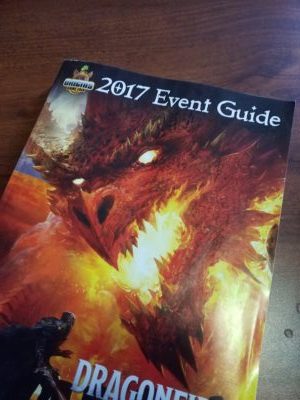

Origins 2017
This was my first trip to the Origin’s Game Fair in Columbus Ohio. This convention is smaller than GenCon with fewer exhibitors and much wider asile space in the exhibit hall. There were many great demo spaces for trying out games. I went for just Saturday during the day.
I didn’t attend any scheduled events; to be fair, I didn’t do a lot of research on what seminars were available, but the whole convention felt more like a place to play games rather than buy games or attend paid seminars. Origins definitely had less of a commercial vibe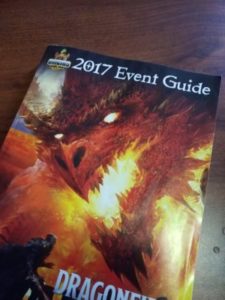 .
.
I found it quite nice to have an exhibit hall that I could explore and feel like I saw everything that I wanted to see. I left Origins with a feeling that I had seen what was there and I didn’t have any underlying concern that I had missed a vendor or missed out on seeing a game and that was a nice feeling.
I didn’t I didn’t stay in a hotel and since I only went one day I don’t have a good price comparison between Gen Con and Origins. I would attend Origins again it was a lot of fun with a lot less pressure and people and crowds.
The Grizzled with expansion and still no W
We tried the Grizzled with the expansion and it was a better experience. The new mission deck mechanic is good for taking pressure off the mission leader and makes each mission unique. Keeping speeches and a more forgiving lucky charm reset does a lot to help make the game feel more winnable.
We lost. It was the very last mission and we might have won but we couldn’t finish the mission and the threat deck ran out. I can see us winning next time.
Solo games becoming more popular
Lately I have noticed that many new boardgames are including a solo option for play. This is good news for those of us who do not have a large gaming community or for those times when you just want to sit and play and everyone else is busy.
The solo games that I’ve been playing are: Robinson Crusoe, Battle for Greyport, and of course Mythos Tales.
Solo game are great for entertaining yourself and getting a board game experience without having to wait for other people. I’m surprised at how theme and style can shape the experience between games. Mechanically most solo game are the same: draw some cards, roll some dice, review the results, repeat.
The nice thing about a well put together solo game is that the theme comes through and you feel like you are exploring a deserted island, or fighting off an invasion force, or tracking down a mystery. Many solo games are great at this.


Review: Mythos Tales from 8th Summit
This review is spoiler-free and all examples and discussions related to game material are entirely made-up.
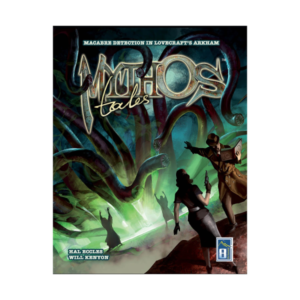
Mythos Tales is an investigation mystery game for one or more people. The player reads an opening story and then decides where to go and who to talk to next. As you read more stories and meet more people, learn about places, find items, and witness happenings you will investigate further until you have enough information to answer the questions at the end of the story or you run out of time. You then use your notes and memory to answer questions for points and see how you did. Be careful, some visits to locations will make you lose sanity.
Bottom Line up front: If you like playing Call of Cthulhu you should seriously check this game out. It has an excellent theme and the stories unfold in true Lovecraft fashion. Sometimes you call on someone just to get mundane info that doesn’t help your investigation. Other times you wander into danger and lose sanity. Some stories are creepy with scared animals, bloodied objects, and strange items.
At each step in the investigation you are taking notes and thinking about the next logical step. Should I visit the West Meeple Street Firehouse and talk to Ned Flanders? Maybe I need to track down the missing bottle of Bent Hill Coconut Porter by heading to the Beverage Baron on King Ave first.
Game play
The game is quite easy to learn. You are given a map, a directory, a newpaper for the day the story starts, and a time tracker. Each investigation has a time limit represented by the X token placed on the end time slot. The time tracker is broken into Days and then Morning, Afternoon, and Evening. You get three spaces to visit each day. The adventure has a recommended solution number and if you exceed that number you’ll lose points from your score. You may not review places you have already visited for facts that might have not made it into your notes or have slipped your mind.
The turn flow is:
- Turn the page to the location you want to visit
- Read the story
- Read/re-read the news paper
- Take copious amounts of notes
- Decide where to visit next –or– Finish the investigation
- Look up the new location’s story number on the map/directory
- Advance the time tracker
- Repeat
Solo play
I have only played the game alone and at night. Probably not going to play again at night due to the game having the ability to foist on some serious heebee geebees. I will be playing this A LOT alone, but during the day or with extra lights turned on. The solo experience is akin to playing a full up CoC game with friends. You get the same feel of making choices for your character and imagining 1920s Arkham. The stories are setup by your friend and mentor Professor Armitage at Miskatonic University. He’s the one sending you out into the city with something to investigate and he’s the one you report to at the end of the game. The mystery is not simplistic and you’ll have several things to consider when trying to pick the next place to visit.
I found myself caring about some of the characters and being down right afraid to run into others. There are characters in the story I connected with (example: That young man who delivers milk is saving money for his kid-sisters operation and he’s been robbed… I need to help him.) There are people in the story I found myself wanting to avoid or tell the police about. (example: The mean waitress at The Wayside Diner who’s always got “ketchup” stains on her apron who’s a known member of the Twilight Silver Lodge)
That was the one thing in the game I thought would pester my or diminish the game play. Example: I figured out that the mean waitress was seen last with the young man near the docks and the newspaper’s lost and found said a pair of men’s shoes washed up on the beach. I’m going to the police station to tell Officer McDaniel about this!
You turn to the Arkham police department story and it’s what you would expect in real life. You talk to the desk cop, or a detective related to the story, or you get there and no one can help you. The story continues. Sure telling the police about the mean waitress would be good and they might take action, but not enough action to derail the narrative. Besides you’re not a cop and they wouldn’t take you along to serve a warrant or arrest someone. Plus those actions take time and you’ve got an investigation schedule to keep. You’ll want to visit another place or end the investigation and score as many points as possible.
I found the narrative of the game was strong enough that I didn’t miss the open sandbox of a multi-player RPG.
Opinion
Absolutely brilliant game for people into the Cthulhu mythos. It’s an almost must buy if you like playing CoC but don’t have a group.
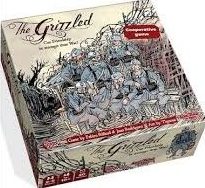

The Grizzled — fun but unwinable
 The Grizzled is a co-operative card game set in the trenches of World War I. This is not a combat game. The focus of this war game is to help each other survive the terrors of war and come out of the conflict alive. There are basically three “suits” and three values of cards and during play your group may only play at most two of any suit or value. The suits are weather related: Snow, Rain, Night. The values are: Shells, Gas, and Whistles. Each card has at least one set of suit and value; others have multiple of these and create quite a problem for the team. The team must play cards from their hand with little/no table talk to see how many cards they can get out of their hands. The goal is to end the round with an empty hand. Good luck with that! There are also hard knock cards that represent wounds and mental problems that manifest during the conflict. These hard knocks modify player choices and create more trouble for the team. For example one hard knock card makes you retreat when any pair of suit or value is in play. This makes you stop discarding cards and sets you up for a more challenging next round.
The Grizzled is a co-operative card game set in the trenches of World War I. This is not a combat game. The focus of this war game is to help each other survive the terrors of war and come out of the conflict alive. There are basically three “suits” and three values of cards and during play your group may only play at most two of any suit or value. The suits are weather related: Snow, Rain, Night. The values are: Shells, Gas, and Whistles. Each card has at least one set of suit and value; others have multiple of these and create quite a problem for the team. The team must play cards from their hand with little/no table talk to see how many cards they can get out of their hands. The goal is to end the round with an empty hand. Good luck with that! There are also hard knock cards that represent wounds and mental problems that manifest during the conflict. These hard knocks modify player choices and create more trouble for the team. For example one hard knock card makes you retreat when any pair of suit or value is in play. This makes you stop discarding cards and sets you up for a more challenging next round.
After everyone retreats or runs out of cards in their hand you have a Support phase and you lend your support to a teammate. Whoever gets the most support gets a benefit. If there is no most supported person there’s no benefit for anyone. This creates more interesting choices and some social cooperation.
The game is excellent and the theme is surprisingly emotive. The game makes you feel like you want your team to survive these awful missions and make it out alive. If anyone dies the game is instantly over. This makes for good game play and when things go bad you know it and are finished soon. It’s not like Eldritch Horror where you know you cannot win but still have 2 hours of game to play to prove you’ve lost. In The Grizzled if you have a few bad missions you’ll be dead soon and then it’s time to shuffle the decks and try again.
That’s one of the great things about this game. Even after being beaten up several times we wanted to play more. Some games that are hard to win eventually stop showing up on the table because everyone knows, “yep here comes another beating, let’s play something else” — with The Grizzled there’s always that urge to try just one more time and see if we can’t make it out of the trenches alive this time.
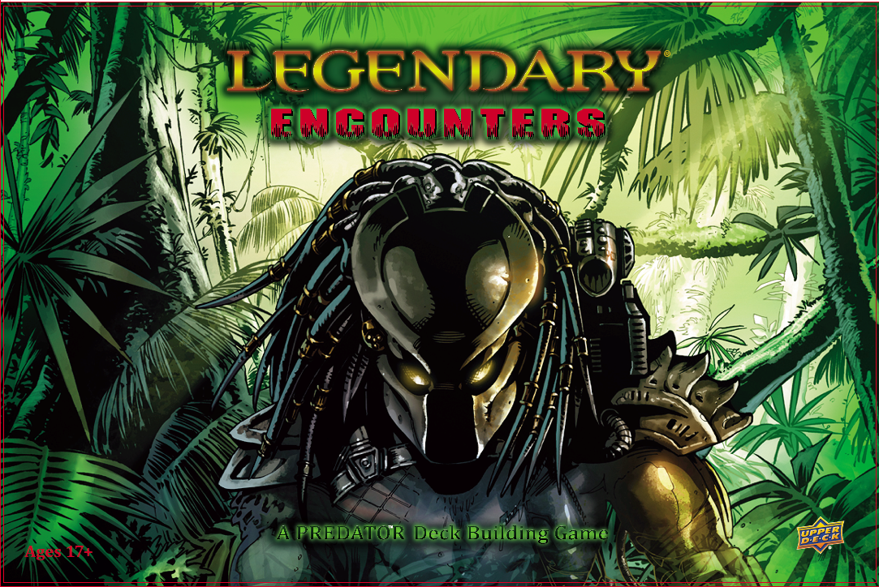

Legendary Encounters: Predator (Review)
After playing several games of Legendary Encounter: Alien I was very excited to get time to sit down with Predator. The setup for Predator is a little more complicated since there’s really four different games in the box. There are two games where you play through each of the two movies trying to achieve objectives from the plot. In game one you have to find and eliminate the rebel camp, then set up a defensive position, and finally “Get to da Choppa” Game two is the plot of the second movie. The other two games put you in the same settings, but you take on the role of the predator hunting trophies. This means that you have separate strike, coordinator, and barracks decks. You need to find the right set of decks for the species that you are playing.
I played two solo games and this game is tough. It felt much more difficult than Alien. Many of the cards have reveal effects and they are awful. I wound up losing expensive and powerful cards from my deck thanks to a few of these reveal effect enemies. That was enough to cause my next few hands to be so weak that I was overwhelmed with predators and slaughtered on my way to da choppa.
The second game had me well into the second objective event cards before I had cleaned out the rebel camp. I managed to beat back the rebels and set up my defenses before the really dangerous enemies appeared. It was very close. I managed to jump on da choppa with three predators on my heels looking to give me enough strike cards to kill me.
I like this game. It is a wonderful, tense, and at time scary solo experience. Just like the Alien game you take cards face down off the event deck and put them into the wilds. You don’t know what sort of danger you’re facing until you scan it and sometimes scanning along costs you dearly.
I have not played the Alien/Predator crossover game but that’s next on my list.
Long time no updates
So there has been a long lag between updates here at Gamemeisters. It’s not that we aren’t doing anything; we are. It’s just that we don’t have any news to post. We’ve been playing games and there will be several review posted soon…
Steampunk Rally review
 Steampunk Rally is a drafting/dice-rolling and placement/racing game from Roxley games. The main idea of the game is that you are a turn of the century inventor building a contraption to race other inventors around the Swiss Alps (or on a track in Paris.) You draft cards to get parts for your machine, dice to power your machine, or cogs to help repair your machine. You roll dice to see what part of the contraption you can activate. The contraptions moves along the track. Finally you check to see how much damage you take.
Steampunk Rally is a drafting/dice-rolling and placement/racing game from Roxley games. The main idea of the game is that you are a turn of the century inventor building a contraption to race other inventors around the Swiss Alps (or on a track in Paris.) You draft cards to get parts for your machine, dice to power your machine, or cogs to help repair your machine. You roll dice to see what part of the contraption you can activate. The contraptions moves along the track. Finally you check to see how much damage you take.
It sounds like a lot of things are happening and when you watch a game you may get lost quickly. Game play is simultaneous. No waiting and watching here; you work on your invention and race at the same time.
There is some order to the chaos, the game is broken down into four phases:
Draft phase
You take one of the four types of cards and make a hand. Select a card and play it then pass the cards in the direction of the game play token (either clock or counter-clock wise.) After you play four cards, you have finished the draft phase. Cards are either: added to your contraption, discarded to gain cogs. discarded to gain dice, or kept in order to play later (if it’s a boost card.) There are several copies of each card so spending a coal burner this turn doesn’t mean you won’t see another coal burner card for the rest of the game. You’ll see another one, probably two. There are enough cards to see variety. You won’t see the same three parts over and over again. After only a few plays it seems well balanced.
Vent phase
Dice you play on your invention stay. Let’s say you used steam (blue dice) to drive your wheels last turn. Those steam dice are still stuck there on the contraption until you vent them. You can’t just keep tossing steam at that part of the machine without proper maintenance. Cogs are spent during the vent phase to clean and grease and generally fix up a part. 2 pips worth of maintenance happens for each cog spent. It’s a nice way of balancing out powerful machine parts that need high numbers (5’s and 6’s) to activate. Great, you use the time machine to get shielding and cogs but it’s going to take a lot of cogs during the next vent phase to reset the time machine back to working order.
Race phase
This is where the fun is. You roll any dice you picked up in the draft and you activate parts of your invention. Some parts move you; others generate dice; still others give you cogs or shield you from damage or even vent dice for you. The key for me is to try to build a machine that can with one set of dice (red for example) generate other dice and cogs while using those newly generated dice to move.
Damage phase
You take damage as you move around the track or if you activate certain parts or use boost cards. That damage is recorded on a counter and in the damage phase you lose parts equal to the number of damage taken. You can generate shields using certain parts that soak the damage. If you lose all your parts you explode and get sent to last place. You never get completely kicked out of the game.
Tips
Spend some time building your machine. If you move right away you can wind up exploded rather suddenly. My first game I was Ada Lovelace and I got a fist full of steam dice and tried to jump out ahead only to explode since I took three damage and had only one part to lose. My second game I took more time constructing the machine and then started out down the track. I didn’t explode that game and won by coasting two space past my opponent.
I find it helpful to plan a turn for a specific activity. Example: this turn I’m collecting cogs to vent since my contraction is packed full of spent dice –or– this turn I’m going to move as much as possible since I’m sitting on a +3 shield value. I haven’t found a way to do a bunch of venting and racing on the same turn, but perhaps I haven’t found the sweet spot between collecting cogs and grabbing dice yet.
Conclusion
It’s fun! After three or four turns you pick up on the phases and learn the symbols. They are easy to follow and there’s a helpful card for player reference. By the end of the game everyone I’ve played with is working their vent and race phases on their own. It’s exciting to see the machine you’ve cobbled together generate dice and cogs and move along the track. There’s something in this game for everyone. Drafting, rolling dice, placing dice (aka worker placement), resource management (collecting and spending cogs) and racing. All the mechanics work together to make the game go and none of them felt as an extraneous addition (i.e. “Quick! toss in drafting to attract 7 Wonders fans who cares if it doesn’t make sense for the game, <insert marketing jerk laughter here>”) There is hardly any down time and a little analysis paralysis when selecting cards or picking the order of machine parts to activate but it hasn’t made the game unfun or overly slow.
This is rapidly becoming my favorite game!
